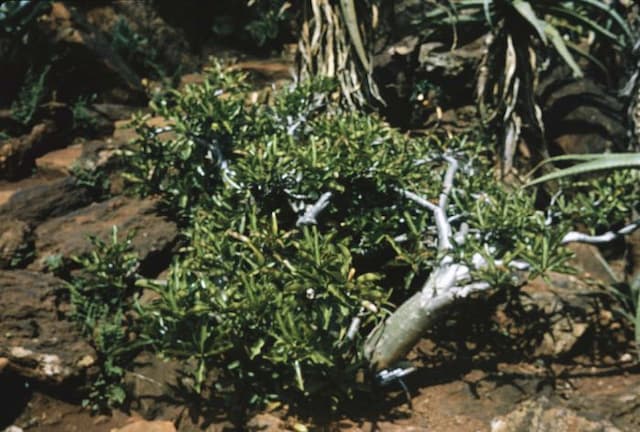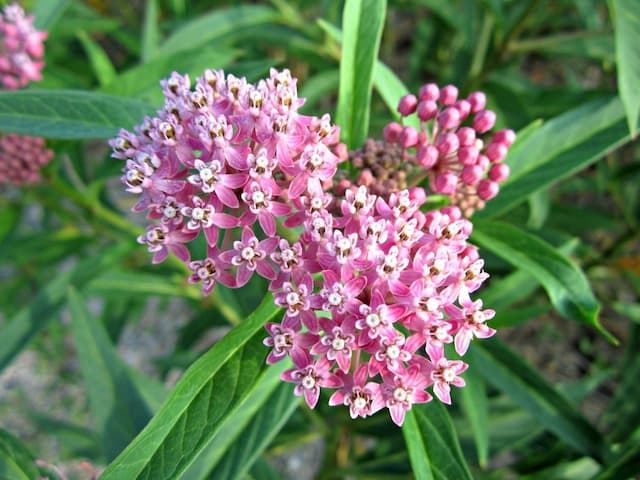Asian Jasmine Trachelospermum asiaticum 'Pink Showers'

ABOUT
The Pink Showers variety of the Asian jasmine is a charming, evergreen climber that is coveted for its ornamental qualities and resilience. It features delicate, glossy foliage that forms a dense mat of leaves. The leaves are oval-shaped and maintain a vibrant green hue throughout the year, creating a lush backdrop for its standout feature: the flowers. The blossoms of the Pink Showers Asian jasmine are particularly striking. As its name implies, it boasts clusters of pink flowers. These blooms display a gentle gradation in color, exhibiting deeper pink hues at the petal edges and softening to a paler pink toward the center. Some might even present a creamy white center, adding to the visual complexity of the flower. The scent of the flowers is also noteworthy; they emit a pleasing fragrance that becomes more pronounced in the warmer months, typically attracting pollinators and providing an aromatic experience for passersby. The twining nature of the stems allows this plant to gracefully climb trellises, fences, and other supports, sometimes showcasing its blooms as if they were cascading from above. In summary, the Pink Showers Asian jasmine presents itself with alluring pink blossoms, a fragrant aroma, and a profuse, glossy green leaf coverage that appeals to those seeking a decorative climbing plant for their garden space.
About this plant
 Names
NamesFamily
Apocynaceae.
Synonyms
Asian Jasmine Pink Showers, Asiatic Jasmine Pink Showers, Pink Showers Star Jasmine, Variegated Star Jasmine Pink Showers.
Common names
Trachelospermum asiaticum 'Pink Showers'.
 Toxicity
ToxicityTo humans
Asian jasmine, specifically the variety referred to as Trachelospermum asiaticum 'Pink Showers', does not have a widely known or significant toxic effect on humans. However, it is generally recommended to avoid ingestion of ornamental plants since some may cause digestive discomfort or more severe symptoms in sensitive individuals. If Asian jasmine is ingested and symptoms occur, they may include nausea, vomiting, or diarrhea. It is best to consult with a medical professional if ingestion occurs and any adverse reactions are experienced.
To pets
Asian jasmine may have mild to moderate toxicity to pets if ingested. Symptoms of poisoning in pets can include vomiting, diarrhea, and less commonly, depression or lack of coordination. If a pet consumes Asian jasmine and exhibits any concerning symptoms, it is important to contact a veterinarian for advice and possible treatment. It is always recommended to prevent pets from ingesting plants that are not specifically intended for animal consumption.
 Characteristics
CharacteristicsLife cycle
Perennials
Foliage type
Evergreen
Color of leaves
Green
Flower color
Pink
Height
1-2 feet (0.3-0.6 meters)
Spread
1-2 feet (0.3-0.6 meters)
Plant type
Climber
Hardiness zones
7
Native area
Asia
Benefits
 General Benefits
General Benefits- Attractive Aesthetics: Produces pink-hued star-shaped flowers that add color and visual interest to gardens.
- Fragrant Flowers: Emits a pleasant scent, enhancing the sensory appeal of outdoor spaces.
- Evergreen Foliage: Maintains green leaves throughout the year, providing continual foliage cover.
- Versatility in Landscaping: Can be used as ground cover, in containers, on trellises or as part of border plantings.
- Drought Tolerance: Once established, it is relatively drought-resistant, requiring less frequent watering.
- Low Maintenance: Requires minimal pruning and upkeep, making it suitable for low-maintenance landscaping.
- Wildlife Support: Attracts pollinators like bees and butterflies, supporting local ecosystems.
 Medical Properties
Medical PropertiesThis plant is not used for medical purposes.
 Air-purifying Qualities
Air-purifying QualitiesThis plant is not specifically known for air purifying qualities.
 Other Uses
Other Uses- As an ingredient in perfumes: The sweet, fragrant flowers of the Asiatic jasmine 'Pink Showers' may be used to create natural perfumes and scented oils.
- For creating natural dyes: The flowers may also be used to produce a light-colored dye for fabrics or crafts.
- In art for flower pressing: The attractive flowers of the Asiatic jasmine can be pressed and used in botanical art or craft projects such as handmade cards or bookmarks.
- As a part of living fences: The vines of the Asiatic jasmine can be trained to grow along fences, creating a living privacy screen with a splash of color.
- For educational purposes: The plant can be used in schools or educational programs to teach students about climbing plants and their growth habits.
- For thematic gardening: Asiatic jasmine 'Pink Showers' can be used to create specific garden themes, such as a 'pink' garden or a fragrance-themed garden.
- As a food garnish: Although not commonly consumed, the flowers may serve as an ornamental garnish for special gourmet dishes or desserts for their elegant appearance.
- In aromatherapy: The scent from the flowers can be used in aromatherapy practices to induce relaxation or improve the ambiance of a space.
- As a part of bridal bouquets: The delicate nature of the flowers makes them an unconventional but possible addition to bridal bouquets or wedding decorations.
- In photography: The plant's cascading flowers and rich green foliage make it an excellent subject for botanical photography and background framing.
Interesting Facts
 Feng Shui
Feng ShuiThe Asian star jasmine is not used in Feng Shui practice.
 Zodiac Sign Compitability
Zodiac Sign CompitabilityThe Asian star jasmine is not used in astrology practice.
 Plant Symbolism
Plant Symbolism- Everlasting Love: Similar to other star-shaped flowers, the Trachelospermum asiaticum 'Pink Showers', commonly known as Asiatic Jasmine, symbolizes enduring affection due to its perennial nature and the long-lasting blooms.
- Purity: The delicate and pure-looking blossoms represent cleanliness and innocence.
- Beauty: The inviting look and fragrance of the Asiatic Jasmine flowers symbolize beauty and are often used to enhance the aesthetic appeal in gardens and landscapes.
- Attachment: The plant's growth pattern, where it clings to supports, suggests ideas of attachment and close bonds, whether in family, friendship, or romance.
- Peace: The serene appearance and subtle fragrance of the flowers can represent tranquility and the calming of emotions.
 Water
WaterThe Asiatic jasmine 'Pink Showers' should be watered thoroughly, approximately once a week, allowing the soil to dry out slightly between waterings. It is essential to avoid waterlogging the roots, so ensure proper drainage. In hotter, drier conditions, watering frequency may increase, and the plant may benefit from an additional watering. The amount of water typically required might be around 1-2 gallons per week, depending on climate conditions and soil type. During the winter months, when the plant is not actively growing and evaporation rates are lower, reduce the frequency.
 Light
LightAsiatic jasmine 'Pink Showers' thrives best in partial to full sunlight conditions. Ideally, it should get at least 4 to 6 hours of sunlight per day. The best spot for the plant would be one where it receives morning sunlight and partial shade in the afternoon, which helps protect it from the intense heat of the day, thus providing a more consistent light exposure.
 Temperature
TemperatureAsiatic jasmine 'Pink Showers' prefers a temperature range between 60°F and 80°F, which are its ideal growing conditions. It can withstand minimum temperatures down to about 10°F but may suffer frost damage. Maximum tolerable temperatures are around 100°F, beyond which the plant may experience heat stress.
 Pruning
PruningAsiatic jasmine 'Pink Showers' is usually pruned to maintain shape and encourage dense growth. Prune in late winter or early spring before new growth begins. You can also prune after flowering to remove any unruly or overgrown branches. Pruning may be done at least once a year, or more frequently if desired for shape.
 Cleaning
CleaningAs needed
 Soil
SoilAsian Jasmine 'Pink Showers' thrives in a well-draining soil mix composed of potting soil, peat, and perlite or sand, with a pH range of 6.0 to 7.5. Rich organic content is beneficial for its growth.
 Repotting
RepottingAsian Jasmine 'Pink Showers' should generally be repotted every 2 to 3 years to prevent becoming root-bound and to refresh the soil.
 Humidity & Misting
Humidity & MistingAsian Jasmine 'Pink Showers' prefers moderate to high humidity levels, ideally between 40% to 80%, to thrive indoors or in a greenhouse.
 Suitable locations
Suitable locationsIndoor
Place in bright, indirect light with some humidity for Asian Jasmine 'Pink Showers'.
Outdoor
Plant in partial shade with shelter; mulch and water consistently for Asian Jasmine 'Pink Showers'.
Hardiness zone
7b-10 USDA
 Life cycle
Life cycleThe life cycle of Trachelospermum asiaticum 'Pink Showers', commonly known as Asian Star Jasmine, begins with germination from seed, although cultivation typically involves propagation from cuttings. Once established, the plant enters a juvenile vegetative stage where it develops long, twining stems and glossy, evergreen leaves. It matures over several years, during which it will begin to flower, producing its distinctive pink blossoms, often most profuse in late spring or early summer. After the flowering period, the plant may produce small, inconspicuous seed pods if pollination occurs. Asian Star Jasmine then enters a repeating cycle of growth and dormancy annually, with growth slowing down in the cooler months. Over many years, it can grow into a substantial vine, requiring pruning to manage its size and shape.
 Propogation
PropogationPropogation time
Spring to Summer
The most popular method of propagation for the Trachelospermum asiaticum 'Pink Showers', commonly known as Asian Star Jasmine, is through semi-hardwood cuttings. This typically takes place during the summer when the wood of the new growth has begun to mature but is not yet fully hardened. To propagate by cuttings, one would take a 4 to 6 inch length of semi-hardwood, strip the leaves from the bottom half, and possibly apply some rooting hormone to the cut end to encourage root growth. The cutting is then planted in a well-draining soil mix and kept moist until roots have developed, which usually takes a few weeks to a few months. Ensure that the cutting is kept in a warm, indirect light environment to provide the best conditions for root development.









